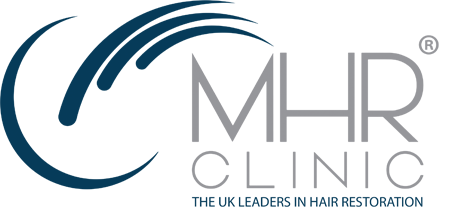
FUE hair transplants are simple surgical procedures that cause very little, if any, visible scarring in the long term.
By following our consultants’ best practice advice after a hair transplant, clients can ensure their scalp heals fully and without any trace of their transplant being visible to the eye.
In this blog post, we review the contributing factors around how to heal a hair transplant quickly, so no sign of surgery remains.
And so our clients can return to normal life as soon as possible after a FUE procedure.
Topical and medical treatments for healing a hair transplant
Clients leave MHR Clinic’s surgery practice with a bandage applied to their donor area and a protective cap over their recipient area.
While the cap may be removed once home, the bandage on the donor area should be removed once 24 hours has elapsed after the procedure.
Clients will then be able to see a pattern of small red scabs forming around follicles in the recipient area.
The donor area will exhibit a series of microscopic red holes from which follicles have been extracted.
It is common to feel tightness, swelling, itching or other irritation in the scalp within and around the recipient area, and sometimes donor area, in the days following a hair transplant.
These sensations are caused by the healing process. They should not cause alarm.
MHR Clinic provides a saline solution, antibiotics and steroid anti-inflammatories to ensure the clean and quick healing of microscopic wounds left by a FUE procedure.
The saline should be applied to both donor and recipient areas every half hour while awake, without fail, for seven days following a hair transplant. This saline application serves to clean the wounds, keep them moist and help them heal with minimal scarring.
Antibiotics and steroid anti-inflammatories should be taken as prescribed to avoid infection in the areas which are healing.
These practices should ensure any discomfort caused by the procedure and its healing subsides within four to five days of a FUE procedure.
It is very important not to touch the implanted grafts with fingers, or anything else for that matter.
No hair products – including shampoos, gels, waxes, creams, pastes and hair fibres – should be applied to the newly implanted follicles or surrounding hair.
When to return to work after hair transplant
Rest is key to the successful healing of a hair transplant. MHR Clinic advises clients not to return to work for at least three days following a hair transplant.
This is to ensure movement of the body is kept to a minimum during a critical period in which follicles settle into their new environment on the scalp.
It helps to avoid any knocks or disturbances that may dislodge them.
Clients whose jobs entail sedentary work may return to their occupations after three days.
Those working in manual employment are advised not to return to work for one week after their FUE procedure.
The head must also remain above the heart for seven days after FUE surgery, to avoid blood pressure encouraging the displacement of newly planted follicles from within the scalp.
Therefore, jobs that entail bending down, heavy lifting and significant movement of the head should be avoided for one week.
For this matter, clients are advised to abstain from strenuous exercise, swimming and any sweating for two weeks after FUE surgery also.
MHR Clinic can provide a doctor’s note if required to substantiate the need for this approach to healing a hair transplant successfully.
To ensure an easy healing period, hair transplant patients should also be careful in how they wash their hair after a hair transplant.
What to eat after hair transplant
Hair is made of protein and protein helps healing. A high protein diet is advised for two weeks following a hair transplant.
For this reason, post procedure clients are advised to pack mealtimes with chicken, fish, eggs, milk, and cheese, beans, nuts and seeds – all of which contain essential amino acids good for healing.
Vitamin E is an antioxidant which cleans cells. It helps to accelerate the healing of damaged skin and prevents scars from becoming permanent. Healthy amounts of avocado, almonds, spinach, sunflower seeds and olive oil after a hair transplant help to keep skin rich in vitamin E.
Zinc plays a big role in tissue repair, helping the body to produce collagen and absorb protein, as well as vitamins and minerals. Eating beef, spinach and cashew nuts will help healing after a hair transplant.
Iron boosts the flow of oxygen and nutrients to hair roots and the scalp. It also supports a strong immune system which is critical for good healing after a hair transplant. Beef, spinach and beans provide rich sources of iron.
MHR clinic strongly advises clients to avoid junk food during the healing phase after a hair transplant.
Alcohol should also be avoided for the first week after FUE surgery.
If you want to understand more about how a hair transplant can reverse your hair loss, please talk to MHR Clinic about the options available to you. Telephone 01565 745 344 or through this contact page.


